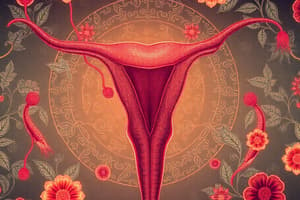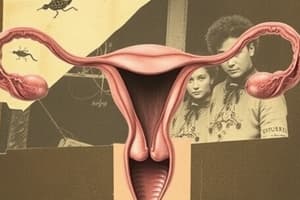Podcast
Questions and Answers
Match the following components with their role in the human female reproductive system:
Match the following components with their role in the human female reproductive system:
Ovaries = Contain eggs Uterus = Where embryo develops until birth Fallopian Tubes = Site of fertilization Vagina = Birth canal
Match the following components with their role in the human male reproductive system:
Match the following components with their role in the human male reproductive system:
Testis = Produces sperm cells Epididymis = Stores sperm cells Vas Deferens = Transports sperm out of the body Penis = Organ for ejaculation
Match the following reproduction types with their descriptions:
Match the following reproduction types with their descriptions:
Sexual Reproduction = Involves two individuals combining genetic information Asexual Reproduction = One individual creating a copy of itself without a partner Internal Fertilization = Fertilization occurs inside the body External Fertilization = Fertilization occurs outside the body
Match the following animal examples with their unique reproductive adaptations:
Match the following animal examples with their unique reproductive adaptations:
Match the following stages with their location in the human female reproductive system:
Match the following stages with their location in the human female reproductive system:
Match the following reproductive method with its description:
Match the following reproductive method with its description:
Match the following organisms with the method used for their reproduction:
Match the following organisms with the method used for their reproduction:
Match the following pollinators with the method they use to spread pollen:
Match the following pollinators with the method they use to spread pollen:
Match the following advancements in technology with their application in reproduction:
Match the following advancements in technology with their application in reproduction:
Match the following cloned animals with their species:
Match the following cloned animals with their species:
Flashcards are hidden until you start studying
Study Notes
Reproduction Systems
Reproduction is the process by which organisms create new offspring. This can occur through sexual reproduction, where two individuals of different sexes combine their genetic information, or asexual reproduction, where one individual creates a copy of itself without the need for another partner. Here we will explore some aspects of the reproductive system and how it works to produce new life.
Human Reproductive System
The human reproductive system consists of both male and female components that work together to produce children. In females, the primary organs involved are the ovaries, uterus, fallopian tubes, cervix, and vagina. Ovaries contain eggs, which are released during ovulation. After fertilization in the fallopian tube, the embryo travels down the fallopian tube to the uterus, where it implants into the lining and develops until birth. In males, the testis produces sperm cells, which are stored in the epididymis before being transported out of the body via ejaculation.
Animal Reproductive Systems
Animal reproductive systems vary widely depending on the species, with many exhibiting unique adaptations for successful reproduction. For example, animals like seahorses have complex mating rituals involving male pregnancy, while insects use internal fertilization methods due to their small size. Some animals also exhibit external fertilization through laying eggs, such as fish and frogs.
Plant Reproductive Systems
Plant reproduction generally occurs through seeds or spores produced in structures called flowers. These are often brightly colored and fragrant to attract pollinators like bees, birds, or wind. During flowering, plants release pollen from their stamen onto the stigma of other plants' pistils, facilitating cross-pollination and ensuring genetic variation among offspring.
Cloning
In recent decades, advances in technology have allowed scientists to manipulate DNA for cloning purposes. While this was once thought of only in the realm of science fiction, today cloned animals exist—from Dolly the sheep in 1996 to more recently cloned endangered animals like black rhinos and Przewalski`s horses.
Artificial Insemination
Artificial insemination involves the direct transfer of sperm into a female's reproductive tract, usually bypassing natural intercourse. It has been used successfully in humans, livestock, and pets to facilitate breeding under controlled conditions, as well as in cases of infertility.
Studying That Suits You
Use AI to generate personalized quizzes and flashcards to suit your learning preferences.




